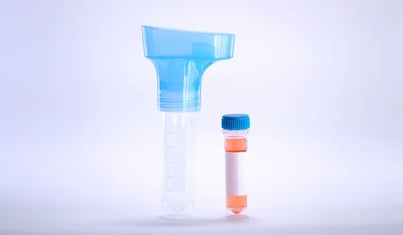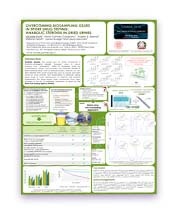Share this
analyzing dried urine microsamples from athletes
by James Rudge, PhD, Technical Director, Trajan on Nov 15, 2021 9:00:00 AM
 An article published in the September 2021 issue of the Journal of Pharmaceutical and Biomedical Analysis, reported on the use of dried urine samples for the measurement of banned peptide hormones in athletes.
An article published in the September 2021 issue of the Journal of Pharmaceutical and Biomedical Analysis, reported on the use of dried urine samples for the measurement of banned peptide hormones in athletes.
The paper, entitled “Enhanced urinary stability of peptide hormones and growth factors by dried urine microsampling,” quantitatively measured 13 peptides using HPLC-MS/MS.
The research team, led by Michele Protti et al in the Pharmaco-Toxicological Laboratories (PTA) at the University of Bologna, conducted a thorough analytical validation comparing two dried urine sample types: dried urine spot (DUS) and Mitra® devices with VAMS® technology to traditional wet urine samples.
A key finding from the paper was that there was improved stability of peptides in dried urine stored at room temperature compared to wet urine stored at -80° C.
Background on Detection of Peptides Used in Doping
A report from the World Antidoping Agency (WADA) in 2019 showed that there has been an increase in the number of adverse analytical findings (AAFs from Erythropoiesis Stimulating Agents (ESAs), Growth Hormone (GH) and Growth Hormone Releasing Factors (GHRFs).
These naturally occurring peptides act to improve athletic performance through influencing a number of metabolic and biochemical pathways, such as stimulating muscle growth and improving cardiac performance.
Because they are naturally occurring substances, the detection and quantitation of doped peptides is very challenging and requires state-of-the art analytical instrumentation and the development of novel methodologies.
One way to detect and quantitate peptides is to measure transgenic DNA in blood samples, which was discussed in a previous blog review of a study where transgenic erythropoietin (EPO) DNA had been successfully detected from dried blood on Mitra devices.
Although dried blood makes for an attractive matrix to detect many banned substances, as discussed in a recent paper by the Drug Control Centre in the UK measuring anabolic steroids from Mitra dried blood samples, the most popular matrix for measuring banned substances is urine.
Urine has the benefit of being non-invasive and straightforward to collect compared to blood, which typically requires a trained phlebotomist to perform a venipuncture blood draw.
While urine is an attractive matrix for use in doping screens, it has number of drawbacks. The first is that it can be easily tampered with, which has led to reported state-sponsored doping scandals in recent years.
Furthermore, like many wet matrices, certain analytes (e.g., peptide hormones) are unstable in wet urine, requiring the need to freeze urine samples at the point of collection. This leads to costly logistical challenges.
The work conducted by Protti et al shows the promise of using DUS or VAMS as alternative matrices that are more difficult to tamper with, show good peptide hormone stability at room temperature, and are much easier and less expensive to transport from a logistical standpoint.
Dried Urine Peptide Study: Methods & Findings
- Blank synthetic urine was used for method development and validation. To validate the assay for selectivity, urine was used from six volunteers.
- The method was finally tested on urine from three pregnant volunteers whose natural hormone peptides would be elevated and so would make ideal surrogate test candidates.
- Analytical validation was achieved on LC-MS/MS using high-resolution LCMS for confirmation.
- Methods for wet urine, DUS and VAMS extractions were individually developed to allow for optimization on each sample type. Interestingly, WCX SPE was needed to clean up the urine samples before analysis but not for the dried sample types. Indeed, both dried techniques only required extraction in methanol where a mix of vortexing and ultrasound agitation was found to be optimal for extraction efficiency. Interestingly, as an alternative solvent, acetonitrile worked almost as well as methanol for VAMS, but yielded lower results for DUS.
- For both dried techniques, 10 µL samples / samplers were used. For DUS, urine was pipetted onto the Whatman 903 paper and a whole spot extraction was carried out.
- For Mitra with VAMS, the samplers were sampled appropriately and after measuring the collected fluid through gravimetric analysis, the team concluded that the collected volumes were “statistically indistinguishable from those pipetted.” Finally, sampling time was evaluated on Mitra devices with VAMS tips. Five seconds was deemed the optimal sampling time to collect a fixed volume of urine. No over-sampling was observed if the samplers were kept in contact with the urine even for 12 seconds. This finding mirrored the manufacturer’s claim on sampling robustness for blood.
- Both DUS and Mitra devices with VAMS were evaluated for drying time. If kept in sealed bags with desiccant, then drying time was around 1h for both devices.
- Method validation was straightforward for both dried sampling techniques. They passed validation parameters, with no issue with over three orders of magnitude linearity and over 77% extraction yield for all analytes. Furthermore, intra and intraday precision was no greater than 8.9% RSD.
- The key finding from the paper was the stability experiment, where the dried matrices at room temperature were consistently more stable than the wet matrices, even with -80° C storage, as can be seen in the figure below.
- The results showed higher than 88.8% analytical response after 20 days storage at room temperature compared to wet samples showing significantly lower stability.
- An interesting observation was that Mitra-VAMS was consistently more stable than DUS, leading the authors to report that “mean stability was higher for VAMS than DUS for every timepoint.”
- All samples showed poor stability if the urine was left for 3hrs prior to sampling, drying or freezing (wet urine), which led the authors to emphasize the importance of drying or freezing samples immediately.
- When testing the method on urine from three pregnant volunteers, the group was able to identify a number of the analytes in all three of the samples.
Study Authors' Conclusions
- The researchers developed and optimized innovative pre-treatment (extraction) procedures for both DUS and VAMS.
- They developed and fully validated a novel multiplex LC-MS/MS where simultaneous measurement of 13 peptides were achieved over 15-minute runtimes.
- Short-term stability experiments showed that dried urine was “remarkably stable” at room temperature for 20 days.
- Both dried methods recovered 89-98% of the samples over the 20-day time period. They commented that this would be suitable for anti-doping purposes and would reduce storage requirements and transportation costs.
- They highlighted that, due to the small sample volumes and dilutions, hundreds of samples would be needed using the current equipment. They proposed other techniques, such as direct analysis of the sample, which could be scanned multiple times may enhance sensitivity.
- Further stability experiments need to be conducted, such as long-term storage (10 months) and exposure to different temperatures and humidity levels, as well as light. Investigators should also look at other peptides and metabolites and evaluate portable (onsite) detectors.
Final Thoughts
This important piece of work published by Protti et al illustrated the importance of using dried samples for a more efficient and stable collection of urine in antidoping applications.
Use of dried urine samples can also minimize costly logistics and transportation. It was suggested in the paper that dried samples would be more difficult to tamper with, a concern previously expressed by WADA.
The major drawback to the assay was the lack of sensitivity observed, and the researchers suggested using other technologies to improve on this.
Indeed, it may be argued that using a different LC-MS/MS instrumental setup may help to boost sensitivity.
In conclusion, due to the diligence of labs such as the PTA Lab at the University of Bologna, new methodologies are showing that dried urine samples can be excellent and even superior alternatives to traditionally collected wet samples.
Given the increase in AAFs, as reported in the 2019 WADA report, any process that can improve logistics and sample security would be a welcome addition to the box of tools being used in the battle to fight sports doping.
This study paper was summarized for our readers by James Rudge, PhD, Neoteryx Technical Director. This is curated content. To learn more about the important research outlined in this review, visit the original article published in Journal of Pharmaceutical and Biomedical Analysis.
For more information on dried urine collection and analysis, see below.

Share this
- Microsampling (206)
- Research, Remote Research (119)
- Venipuncture Alternative (105)
- Clinical Trials, Clinical Research (83)
- Mitra® Device (73)
- Therapeutic Drug Monitoring, TDM (51)
- Dried Blood Spot, DBS (39)
- Biomonitoring, Health, Wellness (30)
- Infectious Disease, Vaccines, COVID-19 (24)
- Blood Microsampling, Serology (23)
- Omics, Multi-Omics (21)
- Decentralized Clinical Trial (DCT) (20)
- Specimen Collection (18)
- Toxicology, Doping, Drug/Alcohol Monitoring, PEth (17)
- Skin Microsampling, Microbiopsy (14)
- hemaPEN® Device (13)
- Preclinical Research, Animal Studies (12)
- Pharmaceuticals, Drug Development (9)
- Harpera Device (7)
- Industry News, Microsampling News (5)
- Antibodies, MAbs (3)
- Company Press Release, Product Press Release (3)
- Environmental Toxins, Exposures (1)
- July 2025 (1)
- May 2025 (1)
- April 2025 (2)
- December 2024 (2)
- November 2024 (1)
- October 2024 (3)
- September 2024 (1)
- June 2024 (1)
- May 2024 (1)
- April 2024 (4)
- March 2024 (1)
- February 2024 (2)
- January 2024 (4)
- December 2023 (3)
- November 2023 (3)
- October 2023 (3)
- September 2023 (3)
- July 2023 (3)
- June 2023 (2)
- April 2023 (2)
- March 2023 (2)
- February 2023 (2)
- January 2023 (3)
- December 2022 (2)
- November 2022 (3)
- October 2022 (4)
- September 2022 (3)
- August 2022 (5)
- July 2022 (2)
- June 2022 (2)
- May 2022 (4)
- April 2022 (3)
- March 2022 (3)
- February 2022 (4)
- January 2022 (5)
- December 2021 (3)
- November 2021 (5)
- October 2021 (3)
- September 2021 (3)
- August 2021 (4)
- July 2021 (4)
- June 2021 (4)
- May 2021 (4)
- April 2021 (3)
- March 2021 (5)
- February 2021 (4)
- January 2021 (4)
- December 2020 (3)
- November 2020 (5)
- October 2020 (4)
- September 2020 (3)
- August 2020 (3)
- July 2020 (6)
- June 2020 (4)
- May 2020 (4)
- April 2020 (3)
- March 2020 (6)
- February 2020 (3)
- January 2020 (4)
- December 2019 (5)
- November 2019 (4)
- October 2019 (2)
- September 2019 (4)
- August 2019 (4)
- July 2019 (3)
- June 2019 (7)
- May 2019 (6)
- April 2019 (5)
- March 2019 (6)
- February 2019 (5)
- January 2019 (8)
- December 2018 (3)
- November 2018 (4)
- October 2018 (7)
- September 2018 (6)
- August 2018 (5)
- July 2018 (8)
- June 2018 (6)
- May 2018 (5)
- April 2018 (6)
- March 2018 (4)
- February 2018 (6)
- January 2018 (4)
- December 2017 (2)
- November 2017 (3)
- October 2017 (2)
- September 2017 (4)
- August 2017 (2)
- July 2017 (4)
- June 2017 (5)
- May 2017 (6)
- April 2017 (6)
- March 2017 (5)
- February 2017 (4)
- January 2017 (1)
- July 2016 (3)
- May 2016 (1)
- April 2016 (2)



No Comments Yet
Let us know what you think